Intel Xeon E5-2697 v2 and Xeon E5-2687W v2 Review: 12 and 8 Cores
by Ian Cutress on March 17, 2014 11:59 AM EST- Posted in
- CPUs
- Intel
- Xeon
- Enterprise
Scientific and Synthetic Benchmarks
2D to 3D Rendering –Agisoft PhotoScan v1.0: link
Agisoft Photoscan creates 3D models from 2D images, a process which is very computationally expensive. The algorithm is split into four distinct phases, and different phases of the model reconstruction require either fast memory, fast IPC, more cores, or even OpenCL compute devices to hand. Agisoft supplied us with a special version of the software to script the process, where we take 50 images of a stately home and convert it into a medium quality model. This benchmark typically takes around 15-20 minutes on a high end PC on the CPU alone, with GPUs reducing the time.

For PhotoScan, the extra cores and MHz from the Xeons means most in the first stage of the computation. The second stage shows an increas in CPU Mapping Speed, however this is the stage where the GPU can accelerate when in use. Stage 3 benefits more from the MHz of the 8-core model, and the final stage is about even.
Console Emulation –Dolphin Benchmark: link
At the start of 2014 I was emailed with a link to a new emulation benchmark based on the Dolphin Emulator. The issue with emulators tends to be two-fold: game licensing and raw CPU power required for the emulation. As a result, many emulators are often bound by single thread CPU performance, and general reports tended to suggest that Haswell provided a significant boost to emulator performance. This benchmark runs a Wii program that raytraces a complex 3D scene inside the Dolphin Wii emulator. Performance on this benchmark is a good proxy of the speed of Dolphin CPU emulation, which is an intensive single core task using most aspects of a CPU. Results are given in minutes, where the Wii itself scores 17.53; meaning that anything above this is faster than an actual Wii for processing Wii code, albeit emulated.
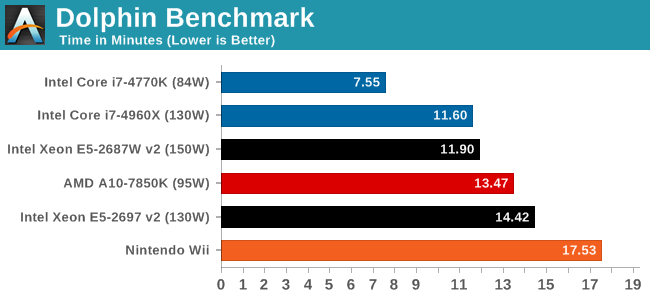
Emulation is a pure single threaded affair, and the IPC improvements of Haswell stand out a lot against the Ivy Bridge-E based Xeons.
Point Calculations – 3D Movement Algorithm Test: link
3DPM is a self-penned benchmark, taking basic 3D movement algorithms used in Brownian Motion simulations and testing them for speed. High floating point performance, MHz and IPC wins in the single thread version, whereas the multithread version has to handle the threads and loves more cores.
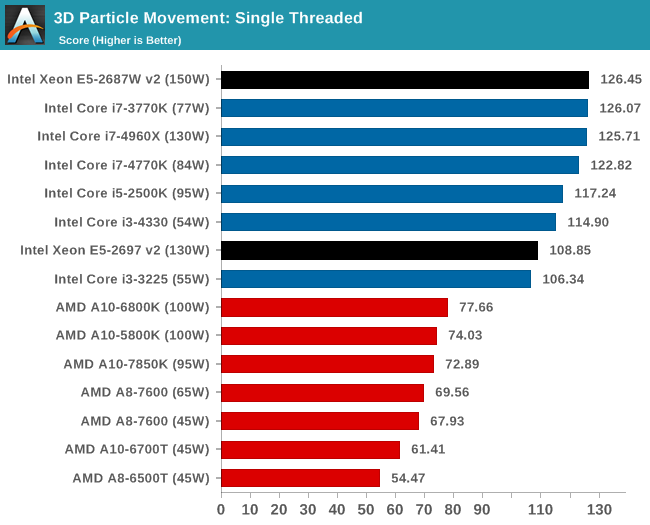
The low core frequency of the 12-core Xeon puts it behind in our FP single threaded benchmark.
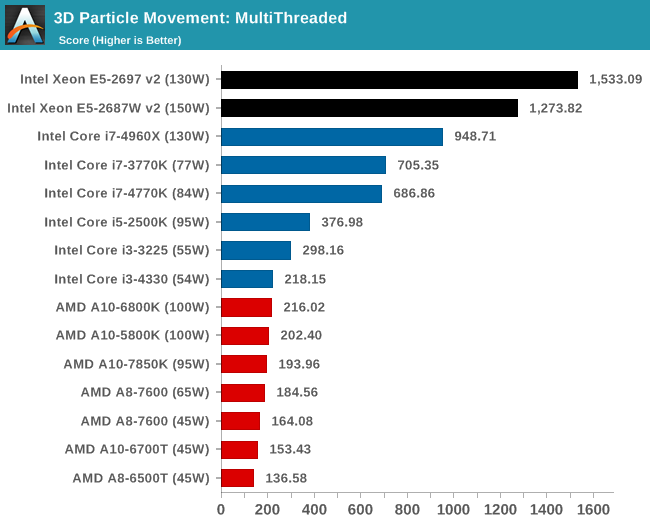
In out multithreaded scenario, we see the situation similar to PovRay, where cores and frequency take top spots.
Encryption –TrueCrypt v0.7.1a: link
TrueCrypt is an off the shelf open source encryption tool for files and folders. For our test we run the benchmark mode using a 1GB buffer and take the mean result from AES encryption.
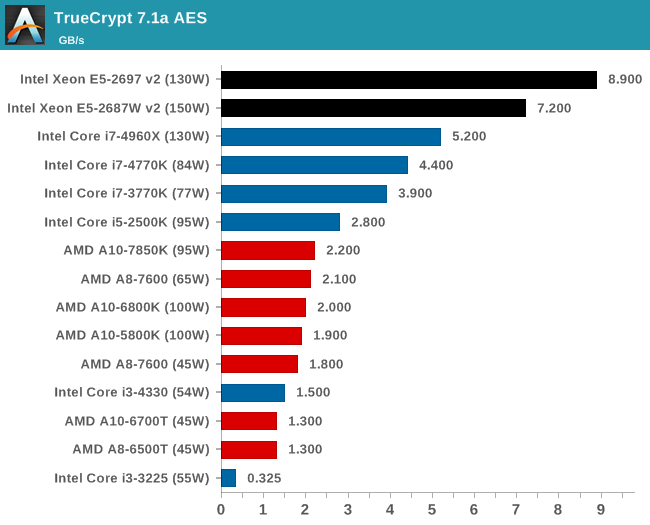
Synthetic – 7-Zip 9.2: link
As an open source compression tool, 7-Zip is a popular tool for making sets of files easier to handle and transfer. The software offers up its own benchmark, to which we report the result.
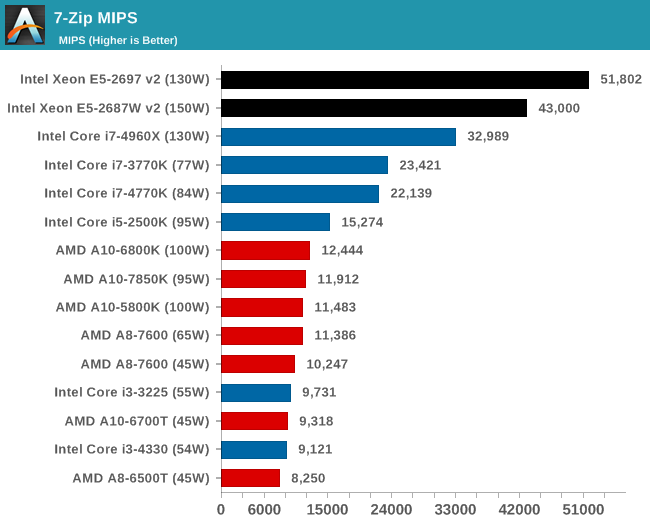










71 Comments
View All Comments
lever_age - Monday, March 17, 2014 - link
Ian, the Xeon E3-1220v3 and E3-1225v3 do not have hyperthreading. They're incorrectly listed in the table as 4c/8t. At those prices, if they did have 8t, more people would be buying them! Also, I think that "c3" by the E3-1230 is a typo.Ian Cutress - Monday, March 17, 2014 - link
Correct, I missed that going through the data.psyq321 - Monday, March 17, 2014 - link
"If the E5-2697 v2 was put in this position, we would have 12 cores at 3.5 GHz, ready to blast through the workload."I do not think this is possible. I have tried to force all cores to turbo mode with ThrottleStop on the 2697v2 Xeon (ThrottleStop bypasses the BIOS/UEFI and codes the limits directly using MSR registers), but the CPU will just refuse to grant this.
I suppose the desktop CPUs simply have this option unlocked, while 2S/4S Xeons have much stricter operating point limits.
The best I can do with 2697 v2 is to set the BCLK to 105 MHz with Z9PE-D8 WS and get 3.15 GHz maximum all-core turbo. This is as much overclock as the system can take.
Ian Cutress - Monday, March 17, 2014 - link
I've managed to get 110 BCLK on both processors relatively stable (112 BCLK needs a push), but this boosts up from the lower multiplier rather than the high one, and there is still a deficit on the high end. Enthusiasts will always want more, and I'd love the chance to run all the cores at the top turbo mode. Given how this is on the consumer line, it makes me wonder why Intel doesn't allow it here. The downside on the consumer line of allowing this behaviour is every so often there is a motherboard that fails to implement any Turbo Core, which has happened in my testing already.psyq321 - Monday, March 17, 2014 - link
I suppose some Intel marketing people just wanted to stop a possibility of lower-end Xeon cannibalizing higher-end Xeons by cheap overclocking. There are markets even in server business that are OK with overclocking (low latency trading, for example).It is interesting that you got it to 110 MHz BCLK. Did you use a server/workstation board or a HEDT (X79) board?
Ian Cutress - Monday, March 17, 2014 - link
This was in the MSI X79A-GD45 Plus, an X79 board. There are some server market areas that do sell pre-overclocked systems in this way, while still using Xeons, if I remember correctly.psyq321 - Monday, March 17, 2014 - link
I think HEDT boards are better when it comes to overclocking, probably due to higher component tolerances.Z9PE-D8 WS is not that good, but then again, it is a 2S board and apart from some Supermicro products (the "hyperspeed" series), the only 2S board that allows at least some overclocking of DDR3 and CPU.
Slomo4shO - Monday, March 17, 2014 - link
I am perplexed by the gaming benchmarks... Any particular reason why the 4770K and A10-7850K don't show up on all of the single and double GPU benchmarks? Especially considering that you have some tri-fire benches of the a10-7850K...Ian Cutress - Monday, March 17, 2014 - link
The AMD does not allow dual NVIDIA cards because the platform does not allow SLI. I need to re-run the 4770K in a PLX8747 enabled motherboard to get 3x SLI results across the board (you cannot get 3x SLI without a PLX chip), and I have not had a chance to run either CPU on my BF4 benchmark which has just been finalised for this review. The A10-7850K and i7-4770K numbers were taken from the Kaveri review and some internal testing - now my 2014 benchmarks are finalised I can run it on more platforms as the year goes on.et20 - Monday, March 17, 2014 - link
Why aren't Xeon E3s the recommended CPUs for enthusiast desktops?They make more sense than the Core i5 and i7 which come with integrated graphics that never gets used.